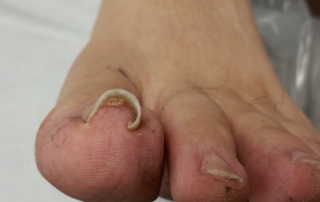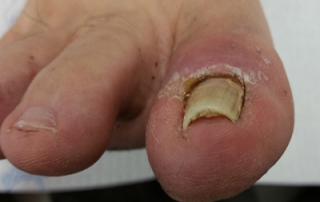Ingrown nails, also known as onychocryptosis, occurs when the sides of the toe nail digs in and pierces the skin causing pain. Ingrown nails are a common nail disorder. It could affect one side or both sides of the nail and digs into the paronychium (skin around the side of the nail).
Ingrown nails could be caused by cutting the nail too short, tight footwear, repetitive trauma or a fungal infection.
Ingrown nails do not heel naturally because the offending nail needs to be removed. If the toe is red, swollen and warm to touch, it may be infected and topical/or oral antibiotics may be needed.
Signs and Symptoms
The most common sign and symptom of an ingrown nail is pain along the sides of the nail when pressure is applied. Pain in footwear or even when the bedsheet is over the toe can cause pain and discomfort. Stubbing the toe will cause a sharp excruciating pain. The skin around the sides of the nail are often swollen and may have hyper-granulation tissue. The hyper-granulated tissue is caused by the body trying to close the wound with the nail imbedded into the skin.
Since an ingrown nail is an open wound, it can become infected. Signs of infection include spreading redness, warm to touch and discharge of pus. People who are living with diabetes should see a foot specialist immediately if they suspect they have an ingrown nail.
Causes
Footwear – One of the most common causes for ingrown nails is ill-fitting/tight footwear. If shoes are too narrow or too small, it will continually put pressure on the nails with every step and may change the shape of the nail.
Genetics – ingrown nails can be hereditary. Family history of ingrown nails may be due to the shape of your foot or the shape of the nails caused by a genetic predisposition.
Trauma related – Heavy objects falling on your toe or having your foot stepped on during sports could change the nail matrix. The nail matrix is where the nail originates and grows out from. If the nail matrix is damaged, the nail will always grow out ingrown.
Fungal Nail Infection – Nail fungus can cause the nail to grow thick and become oddly shaped. A thick nail can cause increased pressure to the corners of the nail and dig deep into the skin. This is particularly true if the nail fungus has traveled to the base of the nail and infected the nail matrix.
Poor Nail Cutting – If you cut your nails too short or at a sharp angle in the corners of the nail, an ingrown nail may form. If you suspect you have an ingrown nail, do not cut the nail yourself. Although you may get short term relief by cutting the nail yourself, you may cause the nail to dig deeper by cutting it at a sharp angle. People living with diabetes should not cut out their own ingrown nails.
How we would treat your ingrown nails
We will assess the ingrown nail and decide the best course of action. On the initial appointment, we will remove the ingrown portion of the nail and provide immediate relief! Proper soaking instructions will be given and topical/or oral antibiotics will be prescribed if needed.
If the ingrown nail is very deep or has persisted for a long period of time, a minor ingrown nail surgery may need to be performed to permanently remove the ingrown section of the nail. Two to Three millimeter will be removed from the side of the ingrown nail, while leaving the rest of the nail intact.
Please feel free to book your appointment at our Whitby office, or Toronto Office. Now serving- Bowmanville, Courtice, Oshawa, Whitby, Brooklin, Ajax, Durham, Pickering, Scarborough, Toronto, Etobicoke, Mississauga, Richmond Hill, Markham, Thornhill.


